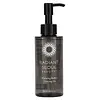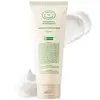What's inside
What's inside
 Key Ingredients
Key Ingredients

 Benefits
Benefits

 Concerns
Concerns

 Ingredients Side-by-side
Ingredients Side-by-side

Water
Skin ConditioningLauramidopropyl Betaine
CleansingDisodium Laureth Sulfosuccinate
CleansingGlycerin
HumectantPropylene Glycol Laurate
Skin ConditioningSodium Chloride
MaskingDisodium Cocoamphodiacetate
CleansingHippophae Rhamnoides Oil
EmollientOlea Europaea Fruit Oil
MaskingButyrospermum Parkii Butter
Skin ConditioningSodium Hyaluronate
HumectantHydrogenated Lecithin
EmulsifyingSqualane
EmollientCeramide NP
Skin ConditioningBetaine
HumectantCaprylic/Capric Triglyceride
MaskingCaprylyl Glycol
EmollientCholesterol
EmollientPhytosphingosine
Skin Conditioning1,2-Hexanediol
Skin ConditioningPhytosteryl/Octyldodecyl Lauroyl Glutamate
Skin ConditioningCitric Acid
BufferingLevulinic Acid
PerfumingSodium Bicarbonate
AbrasiveSodium Benzoate
MaskingC12-14 Pareth-12
EmulsifyingPolyglyceryl-10 Laurate
Skin ConditioningPolyglyceryl-10 Myristate
Skin ConditioningHexylene Glycol
EmulsifyingEthylhexylglycerin
Skin ConditioningLaurylpyridinium Chloride
AntimicrobialParfum
MaskingHexyl Cinnamal
PerfumingWater, Lauramidopropyl Betaine, Disodium Laureth Sulfosuccinate, Glycerin, Propylene Glycol Laurate, Sodium Chloride, Disodium Cocoamphodiacetate, Hippophae Rhamnoides Oil, Olea Europaea Fruit Oil, Butyrospermum Parkii Butter, Sodium Hyaluronate, Hydrogenated Lecithin, Squalane, Ceramide NP, Betaine, Caprylic/Capric Triglyceride, Caprylyl Glycol, Cholesterol, Phytosphingosine, 1,2-Hexanediol, Phytosteryl/Octyldodecyl Lauroyl Glutamate, Citric Acid, Levulinic Acid, Sodium Bicarbonate, Sodium Benzoate, C12-14 Pareth-12, Polyglyceryl-10 Laurate, Polyglyceryl-10 Myristate, Hexylene Glycol, Ethylhexylglycerin, Laurylpyridinium Chloride, Parfum, Hexyl Cinnamal
Water
Skin ConditioningSodium Cocoyl Isethionate
CleansingGlycerin
HumectantSodium Methyl Cocoyl Taurate
CleansingCoco-Betaine
CleansingQuillaja Saponaria Bark Extract
CleansingCitrus Nobilis Peel Oil
MaskingCitrus Aurantium Dulcis Peel Oil
MaskingButyrospermum Parkii Butter
Skin ConditioningMangifera Indica Seed Butter
Skin ConditioningCitrus Tangerina Extract
TonicMoringa Oleifera Seed Oil
EmollientHippophae Rhamnoides Fruit Oil
Skin ProtectingHippophae Rhamnoides Fruit Extract
Skin ConditioningApium Graveolens Extract
Skin ConditioningCitrus Aurantifolia Juice
CleansingCitrus Limon Fruit Extract
MaskingPyrus Malus Juice
Skin ConditioningSpinacia Oleracea Leaf Extract
Skin ConditioningTriticum Vulgare Sprout Extract
Skin ConditioningBeta Vulgaris Root Extract
Skin ConditioningCitrus Aurantium Dulcis Juice
Skin ConditioningCitrus Paradisi Juice
PerfumingPotassium Cocoyl Glycinate
Coco-Glucoside
CleansingSodium Myristoyl Glutamate
CleansingSodium Chloride
MaskingCitric Acid
BufferingPolyquaternium-67
Sodium Phytate
1,2-Hexanediol
Skin ConditioningAscorbic Acid
AntioxidantTocopherol
AntioxidantCaprylic/Capric Triglyceride
MaskingHydrogenated Lecithin
EmulsifyingButylene Glycol
HumectantStearic Acid
CleansingCeramide NP
Skin ConditioningPhytosphingosine
Skin ConditioningCeramide Ns
Skin ConditioningCholesterol
EmollientCeramide AP
Skin ConditioningCeramide As
Skin ConditioningEthylhexylglycerin
Skin ConditioningCeramide EOP
Skin ConditioningCetearyl Alcohol
EmollientLimonene
PerfumingWater, Sodium Cocoyl Isethionate, Glycerin, Sodium Methyl Cocoyl Taurate, Coco-Betaine, Quillaja Saponaria Bark Extract, Citrus Nobilis Peel Oil, Citrus Aurantium Dulcis Peel Oil, Butyrospermum Parkii Butter, Mangifera Indica Seed Butter, Citrus Tangerina Extract, Moringa Oleifera Seed Oil, Hippophae Rhamnoides Fruit Oil, Hippophae Rhamnoides Fruit Extract, Apium Graveolens Extract, Citrus Aurantifolia Juice, Citrus Limon Fruit Extract, Pyrus Malus Juice, Spinacia Oleracea Leaf Extract, Triticum Vulgare Sprout Extract, Beta Vulgaris Root Extract, Citrus Aurantium Dulcis Juice, Citrus Paradisi Juice, Potassium Cocoyl Glycinate, Coco-Glucoside, Sodium Myristoyl Glutamate, Sodium Chloride, Citric Acid, Polyquaternium-67, Sodium Phytate, 1,2-Hexanediol, Ascorbic Acid, Tocopherol, Caprylic/Capric Triglyceride, Hydrogenated Lecithin, Butylene Glycol, Stearic Acid, Ceramide NP, Phytosphingosine, Ceramide Ns, Cholesterol, Ceramide AP, Ceramide As, Ethylhexylglycerin, Ceramide EOP, Cetearyl Alcohol, Limonene
Ingredients Explained
These ingredients are found in both products.
Ingredients higher up in an ingredient list are typically present in a larger amount.
1,2-Hexanediol is a synthetic liquid and another multi-functional powerhouse.
It is a:
- Humectant, drawing moisture into the skin
- Emollient, helping to soften skin
- Solvent, dispersing and stabilizing formulas
- Preservative booster, enhancing the antimicrobial activity of other preservatives
This ingredient is also known as shea butter. It is an effective skin hydrator and emollient.
Emollients help soothe and soften your skin. It does this by creating a protective film on your skin. This barrier helps trap moisture and keeps your skin hydrated. Emollients may be effective at treating dry or itchy skin.
Shea butter is rich in antioxidants. Antioxidants help fight free-radicals, or molecules that may harm the body. It is also full of fatty acids including stearic acid and linoleic acid. These acids help replenish the skin and keep skin moisturized.
While Shea Butter has an SPF rating of about 3-4, it is not a sunscreen replacement.
Shea butter may not be fungal acne safe. We recommend speaking with a professional if you have any concerns.
Learn more about Butyrospermum Parkii ButterThis ingredient is an emollient, solvent, and texture enhancer. It is considered a skin-softener by helping the skin prevent moisture loss.
It helps thicken a product's formula and makes it easier to spread by dissolving clumping compounds.
Caprylic Triglyceride is made by combining glycerin with coconut oil, forming a clear liquid.
While there is an assumption Caprylic Triglyceride can clog pores due to it being derived from coconut oil, there is no research supporting this.
Learn more about Caprylic/Capric TriglycerideCeramide NP is a type of ceramide and formally known as ceramide 3.
Ceramides are intercellular lipids naturally found in our skin that bonds dead skin cells together to create a barrier. They are known for their ability to hold water and thus are a great ingredient for dry skin.
Ceramides are an important building block for our skin barrier. A stronger barrier helps the skin look more firm and hydrated. By bolstering the skin ceramides act as a barrier against irritating ingredients. This can help with inflammation as well.
If you would like to eat ceramides, sweet potatoes contain a small amount.
Read more about other common types of ceramides here:
Ceramide AP
Ceramide EOP
Cholesterol is a class of organic molecules called lipids. It helps hydrate your skin and is essential to having a healthy skin barrier.
Our skin naturally contains cholesterol in the outermost layer. Besides cholesterol, it also contains ceramides and fatty acids. Cholesterol makes up about 1/4 of your skin's outer layer and barrier. Your skin barrier is responsible for keeping allergens and microbes out. Having a healthy skin barrier is also responsible for keeping your skin firm and plump.
Our bodies use cholestrol to create vitamin D, steroid hormones, and more.
Learn more about CholesterolCitric Acid is an alpha hydroxy acid (AHA) naturally found in citrus fruits like oranges, lemons, and limes.
Like other AHAs, citric acid can exfoliate skin by breaking down the bonds that hold dead skin cells together. This helps reveal smoother and brighter skin underneath.
However, this exfoliating effect only happens at high concentrations (20%) which can be hard to find in cosmetic products.
Due to this, citric acid is usually included in small amounts as a pH adjuster. This helps keep products slightly more acidic and compatible with skin's natural pH.
In skincare formulas, citric acid can:
While it can provide some skin benefits, research shows lactic acid and glycolic acid are generally more effective and less irritating exfoliants.
Most citric acid used in skincare today is made by fermenting sugars (usually from molasses). This synthetic version is identical to the natural citrus form but easier to stabilize and use in formulations.
Read more about some other popular AHA's here:
Learn more about Citric AcidEthylhexylglycerin (we can't pronounce this either) is commonly used as a preservative and skin softener. It is derived from glyceryl.
You might see Ethylhexylglycerin often paired with other preservatives such as phenoxyethanol. Ethylhexylglycerin has been found to increase the effectiveness of these other preservatives.
Glycerin is already naturally found in your skin. It helps moisturize and protect your skin.
A study from 2016 found glycerin to be more effective as a humectant than AHAs and hyaluronic acid.
As a humectant, it helps the skin stay hydrated by pulling moisture to your skin. The low molecular weight of glycerin allows it to pull moisture into the deeper layers of your skin.
Hydrated skin improves your skin barrier; Your skin barrier helps protect against irritants and bacteria.
Glycerin has also been found to have antimicrobial and antiviral properties. Due to these properties, glycerin is often used in wound and burn treatments.
In cosmetics, glycerin is usually derived from plants such as soybean or palm. However, it can also be sourced from animals, such as tallow or animal fat.
This ingredient is organic, colorless, odorless, and non-toxic.
Glycerin is the name for this ingredient in American English. British English uses Glycerol/Glycerine.
Learn more about GlycerinHydrogenated Lecithin is created from the hydrogenation of lecithin (a group of phospholipids). Hydrogenation is a chemical reaction between hydrogen and another element.
This ingredient is an emollient and emulsifier. As an emollient, it helps soften skin by trapping moisture within. As an emulsifier, it prevents oil and water ingredients from separating.
Phytosphingosine is a phospholipid naturally found in our skin as a building block for ceramides.. It helps moisturize, soothe, and protect skin.
Phytosphingosine contributes to your skin's natural moisturizing factor (NMF). The NMF is responsible for hydration, a strong barrier, and plasticity. Our NMF decreases with age. Increasing NMF leads to more healthy and hydrated skin.
Studies show products formulated with NMF ingredients help strengthen our skin's barrier. Having a healthy skin barrier reduces irritation and increases hydration. Our skin barrier is responsible for having plump and firm skin. It also helps protect our skin against infection, allergies, and inflammation.
Fun fact: Phytosphingosine is abundant in plants and fungi.
More ingredients that help boost collagen in skin:
Learn more about PhytosphingosineChances are, you eat sodium chloride every day. Sodium Chloride is also known as table salt.
This ingredient has many purposes in skincare: thickener, emulsifier, and exfoliator.
You'll most likely find this ingredient in cleansers where it is used to create a gel-like texture. As an emulsifier, it also prevents ingredients from separating.
There is much debate on whether this ingredient is comedogenic. The short answer - comedogenic ratings don't tell the whole story. Learn more about comegodenic ratings here.
The concensus about this ingredient causing acne seems to be divided. Research is needed to understand if this ingredient does cause acne.
Scrubs may use salt as the primary exfoliating ingredient.
Learn more about Sodium ChlorideWater. It's the most common cosmetic ingredient of all. You'll usually see it at the top of ingredient lists, meaning that it makes up the largest part of the product.
So why is it so popular? Water most often acts as a solvent - this means that it helps dissolve other ingredients into the formulation.
You'll also recognize water as that liquid we all need to stay alive. If you see this, drink a glass of water. Stay hydrated!
Learn more about Water